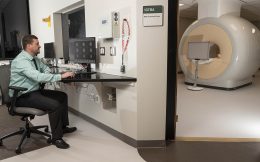Excerpt

Matthew Sherwood, Ph.D., director of Wright State’s Center of Neuroimaging and Neuro-Evaluation of Cognitive Technologies, says the MRI scanner promises to lead to new collaboration between Wright State, the Air Force and researchers at Wright-Patterson Air Force Base.
The area’s only magnetic resonance imaging (MRI) scanner dedicated exclusively to research is operational and may prompt growth at a Greene county college.
Wright State University plans to use the 3 Tesla MRI scanner for human research studies in neuroscience. The university has high hopes for its potential.
“I just think this is something that is really needed in Dayton to help boost regional research and development infrastructure,” said Matthew Sherwood, director of Wright State’s Center of Neuroimaging and Neuro-Evalutaion of Cognitive Technologies.
Sherwood said the MRI will help him in his research on hypoxia, a condition in which the brain is deprived of adequate oxygen. It often occurs in high altitudes or in underwater diving and can result in vertigo and tunnel vision and even subpar performance for the following 24 hours.
Sherwood, who has led nearly $3.5 million in projects funded by the Department of Defense while at Wright State, also sees an opportunity to expand the collaboration with the Air Force and researchers at Wright-Patterson Air Force Base in using the scanner.
“We’re hoping they’re able to bring some of their research here,” he said. “We are committed to partnering with them.”
The grant application for the scanner was written by Sherwood and Assaf Harel, an associate professor of psychology and a cognitive neuroscientist.

MRI operator training sessions began March 29, and human research studies using the scanner will begin over the Summer Semester.
It also marked a collaboration between Wright State, Air Force Research Laboratory’s 711th Human Performance Wing, the Air Force Office of Scientific Research and the state of Ohio.
Harel’s research focuses on uncovering how people perceive their visual surroundings and how the brain develops complex behaviors like navigation, aerial imagery analysis, controlling multiple unmanned aerial vehicles and flight.
Sherwood also is interested in accelerating and improving learning, which would help the military by shortening training and making it more effective.
An MRI uses strong magnetic fields and radio waves to create detailed images of the organs and tissues within the body. It is considered the gold standard for neuroscience research, as it can provide a highly detailed picture of the brain and its activity in real-time.
Wright State has other specialized equipment that can be used with the MRI scanner to study the human brain, such as a projection system that can be placed inside the scanner that flashes images or stimuli and then records the responses of the subjects, Sherwood said.
MRI operator training sessions began March 29. Human research studies using the scanner will begin over the summer.
View the original story at bizjournals.com

 Amy Salazar named vice president for student success at Wright State
Amy Salazar named vice president for student success at Wright State  Fortune ranks Wright State’s online MBA program among the best
Fortune ranks Wright State’s online MBA program among the best  Wright State to host job and resources fair for veterans and their families
Wright State to host job and resources fair for veterans and their families  Studying abroad gives Wright State students impactful learning, growth opportunities
Studying abroad gives Wright State students impactful learning, growth opportunities  Wright State introduces seven new or restructured undergraduate degrees
Wright State introduces seven new or restructured undergraduate degrees 